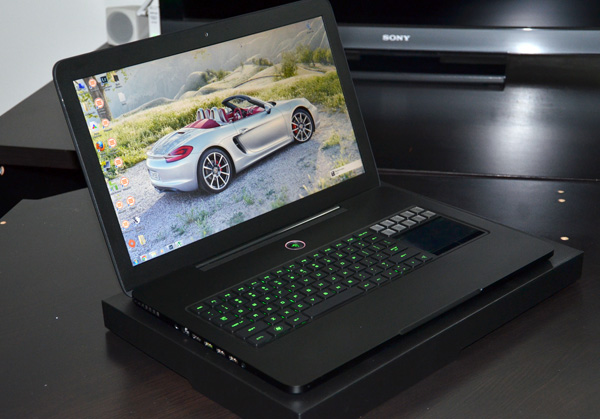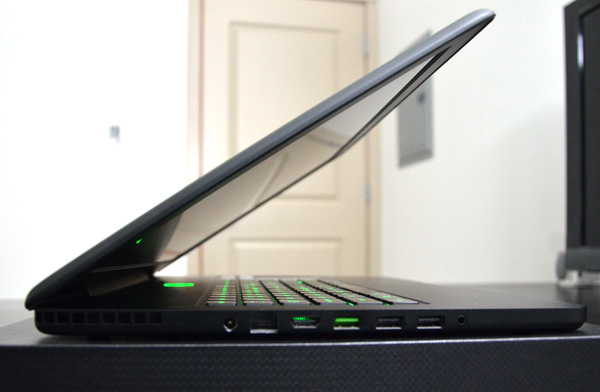The Razer Blade Review
by Vivek Gowri & Jarred Walton on March 15, 2012 3:01 AM ESTThere is something absolutely arresting about the Blade’s overall aesthetic. It’s big, but so strikingly thin at the same time, and the matte black paintjob is like a visual black hole. The overall effect is eye-catching, breathtaking, and will cause random passerby to stop and ask questions.
The design language is really, really clean and rather understated, two things you don’t expect from most gaming notebooks, while still keeping a sense of flair about it. The lid has two ribs vertically arranged on either side of the glowing Razer logo on the back, breaking up the monotony of the otherwise flat profile of the lid. Everything here is very uniformly laid out—lots of rectangles with radiused edges, no extraneous design elements, but unlike Apple’s portables, there’s no feeling of overwhelming sterility. Apple has taken the minimalist design philosophy so far that the MacBook Pro design language feels almost soulless.
The Blade doesn’t have that problem. The flat black aesthetic is offset by green accents—lots of them. The Razer logo on the back lights up in green, the power button has a Razer logo that glows green and pulsates almost like a heartbeat, the USB 3.0 port is green, the keys on the keyboard are green, a lot of the UI elements of the Switchlade panel are green, the list goes on. The industrial design is very clean, but what’s impressive is the overall polish in the design and how the whole thing ties together. It’s the little things—the attention to detail borders on obsessive, and that’s very good to see.
No matter what you think about the specs or the price, it’s impossible to ignore the fact that the Blade is a gorgeous, gorgeous device. It’s very obviously built to a high standard of build quality, with a machined aluminum unibody chassis that, even being so thin, is very structurally rigid. The lid and hinge are also pretty sturdy feeling, and the keyboard has no flex. Nothing about the look and feel of the Blade suggests anything less than a truly premium product.
In terms of ports, the Blade is pretty sparse. There’s one USB 3.0, two USB 2.0, HDMI, gigabit Ethernet, combo headphone jack/line in, and AC power all on the left side of the machine, as well as a Kensington lock on the right side. I’d definitely have liked to see an SD card slot here, along with one more USB 3.0 port, but given the form factor, you can understand why the Blade doesn’t have too much in the way of ports. The reason almost all the ports are on the left side is so that when at a desk using a mouse, gamers won’t ever run into the peripheral devices connected. Close to the back of the unit, there’s vents on either side; GPU on the right, CPU on the left.
The front is also completely clean, other than the angled cutout for opening the latch-less screen. The back of the system is dominated by the hinge, a right-angled piece that borrows from Apple’s playbook for designing low-profile hinges. The bottom of the system is also pretty minimalist, with chrome-ringed heat vents on the right and left sides, FCC information silk screened onto the body, and the Windows COA sticker. The heat vents are nice in that they are angled such that they blow air towards the rear of the notebook, away from the user.
The LCD bezel is thicker than I’d like, but the larger footprint was probably necessitated by the super-thin form factor. Above the display, we find the 2.0MP webcam, mic, and light sensor, while below it we find the highly stylised Blade logo rendered in glossy black. Against the metallic matte black of the rest of the interior, it’s understated yet incredibly cool looking.
The rest of the interior is pretty interesting. First things first, there’s no touchpad in the conventional sense—what happened, effectively, is that the touch-based input device got moved to where the keyboard’s number pad would be, leaving the area underneath the keyboard completely free. The keyboard and Switchblade are important enough to deserve their own page, but the rearranging of the touchpad enabled Razer to do some interesting things with the design. There’s much more space above the keyboard than you’d typically find on a notebook, something that Razer took advantage of by piping most of the heat generated by the CPU and GPU to that area. It’s not somewhere where people typically touch their computers, unlike the bottom or the palmrests, so engineering the thermal system to move heat towards the rear left corner was a good idea. Razer put vents on both sides of the Blade, but a majority of the heat is exhausted from the one on the left because the design team didn’t want hot air blowing on the mouse hand (when using an external mouse). It’s touches like this that impress—it’s rare to find this kind of polish or attention to detail in a company’s first computer.





















95 Comments
View All Comments
JarredWalton - Thursday, March 15, 2012 - link
It's funny how we have all these 3D HDTVs with IPS displays, but somehow the only 120Hz computer displays are TN panels. I suppose maybe the HDTVs only have to deal with HDMI input so they're really only doing 3D with 48Hz (Blu-ray) or 60 Hz (HDTV broadcasts). Anyway, IPS can be very good, though there are people that prefer TN because on paper the specs look better. Look at our IPS display reviews lately, and you'll see that in our real-world testing some TN panels are about 10ms faster "input lag" than IPS:http://www.anandtech.com/show/5550/dell-u2412m-16-...
I'd still go IPS given the choice.
erple2 - Thursday, March 22, 2012 - link
Wait. Are there ANY IPS based HDTVs abailable? When did that happen?shatteredx - Thursday, March 15, 2012 - link
I play fast paced shooters like ut and cs and there's no noticeable input lag or blurring on my dell u2312hm or 2007wpf. I did notice a bit of blurring on my 2007wpf for about the first week after switching from a CRT back in 2006 but my brain adjusted to it quickly.I can't stand the bad viewing angles on tn panels (which are exacerbated on laptops due to variable desk height) and my next laptop will surely have an ips panel.
I just wish a 120hz ips panel would get developed.
Dustin Sklavos - Thursday, March 15, 2012 - link
I personally love my Alienware M17x R3. It's a couple pounds heavier than the Razer Blade, sure, but it's usable. What good is a thin and light form factor for a gaming machine when the thing is obscenely noisy under load, running so hot that out of the box the processor is already near boiling, and features a keyboard that's next to impossible to type on? And then the notebook has problems with sleep mode, AND one of its major selling points is crash prone?I'm sorry, but as an alternate take, from what I've read here I can't agree with the recommendation. Looks are nothing without substance behind them.
weiran - Thursday, March 15, 2012 - link
Personally I can't see myself ever wanted to carry an Alienware M17x anywhere off my desk, and in that case I may you may as well get a desktop. Razor has attempted to make a gaming laptop that's really portable, and have done a very good job. In fact is there even a lighter 17" or even 15" laptop?I think Razor is realising that being just another competitor producing gaming slabs that compete only on spec and price makes no sense; they will have razor (ha) thin margins and just be another player in the game. By creating their own sub-category of device, appealing to a reasonable niche of gamers who want an ultraportable laptop that still has a good discrete GPU, they're in their own market with no direct competition.
I'm glad there's at least one PC manufacturer making something different, and pulling it off.
Dustin Sklavos - Thursday, March 15, 2012 - link
The problem is that if you want something lighter and more portable, the Alienware M14x offers roughly as much performance for half the price. You have to go down to a 1600x900 screen, but that resolution is also better suited to the GT 555M.Penti - Thursday, March 15, 2012 - link
Yup, that would be better and more what I would be inclined to if I where in the market for a gaming laptop. For me GT555M is bare essential minimum here. I don't like the 17" laptops at all and the DTR-models usually just fails. The cheap 1080p panels aren't really to prefer and the graphics aren't powerful enough to drive that in games any way. So I was looking at the M14x closely when it came out and do like it more. I would basically need GT555M or better, and certainly a display above 1366x768 here.Also the M14x is about 1000-1500 USD cheaper so there is really no choice here. Why spend the extra money to get something looking kinda awful and not really have any better performance. Even as gaming laptops goes it look awful. The touchpad-thing is just despicable and just something useless a company like razor could come up with.
bennyg - Thursday, March 15, 2012 - link
I think my P150HM is quite portable. It happily goes from home to office every day and fits in my reasonably-sized backpack. Its under 4kgs, looks like a Thinkpad (!!!), and has a SB quaddy and 580M in it with a cooling design that keeps the laptop cool. And has a fantastic screen (upgrade option 95% gamut matte)When you think how little you add in size and weight the m14x looks silly in comparison as a "gaming" notebook. New refresh model looks like it will add Optimus (for 580M, yes) and backlit keyboard which are really the only two weaknesses. Along with the monstrous poowerbrick... but in the office a 90W 19V does the job.
I don't know what Razer were thinking with this laptop to be honest, it just looks compromised in so many ways. Looks like a gamer-ised MBP that ate a smartphone, Borg-style.
piroroadkill - Thursday, March 15, 2012 - link
I think it's actually fantastic, and I don't have the same complaint about the keyboard layout - it looks reasonable enough to me.I love the changeable keys and the touchscreen touchpad on the right.. it means when you're gaming on the built in keyboard, you won't rest your wrist on the classic touchpad position.
The CPU choice is great, the screen choice is perfectly fine, the thickness is stunning.. Even the battery life is half decent.
The only low point is the slightly inadequete GPU. I'm no Razer fan, I think they make flashy gaming hardware that has sub-par build quality and poor support.. BUT that said, this is a fantastic looking machine, offering some genuinely fresh features into a stagnant market. Shoe-horn a slightly better GPU in there, look at some way to offer it at a cut price (maybe stick a Barracuda XT 750GB in it?), and you have an extremely compelling product.
gostan - Thursday, March 15, 2012 - link
this review is just so sad at so many levels. let's build a supercar, let's fit it with tiny wheels, and let's charge a lot of money for it. then let's get a media to justify the wheel selection..